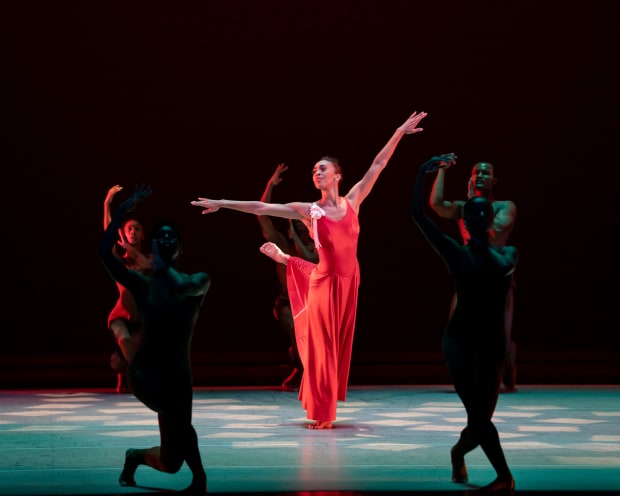
Courtesy of Ailey, DCP
Sports Illustrated and Empower Onyx are putting the spotlight on the diverse journeys of Black women across sports—from the veteran athletes, to up-and-coming stars, coaches, executives and more—in the series, Elle-evate: 100 Influential Black Women in Sports.
Constance Stamatiou never thought her first ballet class would lead to her performing under the stars, to a sold out audience in the ancient, open-air Odeon theater of Athens, Greece. And the Charlotte native certainly didn’t know her Greek father would be watching from the audience, having just reunited with his mother and sister after 10 long years. The rain poured and the resilient audience roared anyway, creating a roof of sorts with their umbrellas, all to see the Alvin Ailey American Dance Theater company’s signature work, Revelations.
“We finally get out there, and we're dancing with these views, with our heads up high,” Stamatiou says. “All you see is the stars, the mountains, and the Parthenon temple lit up. It was like dancing in heaven.” If it sounds like a dream, “it’s because it is,” she adds. But it’s these surreal, otherworldly moments that have kept her buoyed to the Ailey family—and to dance, as an athlete—for years, and through seasons, including motherhood. As she gears up for AAADT’s Lincoln Center season this June, Stamatiou reflects on what it means to carry on the work of founder Alvin Ailey, and to dance on the shoulders of the Black women he so often centered in his work, and his life.
Stamatiou cheekily describes her younger self as “that kid with too much energy.” Her mother’s job at a TJ Maxx up the street from what would become her first dance school, set the course for the rest of her life. “She decided to enroll me there and I just fell in love with dance.” Stamatiou went to North Carolina Dance Theater, which is now Charlotte Ballet and then to a performing arts school, NorthWest School of the Arts. “That led me to pursue dance in college, which brought me to SUNY purchase,” she says. “I studied there for a year and one of my professors was like, ‘What are you doing for the summer?’”
At the time, she had never heard of AAADT, founded in 1958 by visionary choreographer Alvin Ailey. The company grew from a now-historic performance in March 1958 at the 92nd Street YMCA, led by Ailey and a group of young, Black modern dancers. Since then, AAADT has gone on to perform for over 25 million people, in 71 countries and on six continents, and were named “cultural ambassadors to the world” by a 2008 U.S. Congressional resolution. In Ailey’s own words, he wanted to “hold a mirror to society, so that people can see how beautiful they are.” Stamatiou didn’t even realize the myriad of ways she hadn’t felt seen in North Carolina until she touched down in New York City at Ailey’s headquarters as a fellowship student.
The Ailey School is the official school of AAADT, and for some dancers it’s the first step into eventually joining the company or moving onto Broadway. Stamatiou remembers the initial culture shock of training in Hell’s Kitchen. “Growing up in North Carolina, I didn't really know much about Ailey or places like Dance Theatre of Harlem at all,” she says. “All I saw was white ballerinas. So when I got here and there was so much culture, so much diversity, I wasn't expecting that. I didn't know there were so many Black and brown dancers, I was like, Where have I been just sheltered in North Carolina?”

Courtesy of Paul Kolnik
There was something about the Ailey organization that took it a step further for Stamatiou—this was the first space she had been in the dance world where the waif thin body type wasn’t the only acceptable form. She literally saw herself—countless versions of herself, actually—walking around the halls of the school, teaching classes in the studios, gracing stages across the city, the country, the world. “I saw all these bodies and women and men that looked like me. It gave me life, and it made it all more obtainable,” she says. “And when I saw AAADT perform masterpieces that were so relevant to what's going on in the world—so relevant to our ancestors—that really moved me. On top of that, to see that strength while they were performing…I saw athletes. I thought, I can use my gymnastics training with this company too, because they do it all. I have the classical ballet training. If I need to put on a pointe shoe or a ballet slipper, I can do that. But also, if they want me to flip around, or put on a sneaker and do some hip hop or Limón, or Graham, I can do that too.” By 2007, Stamatiou was performing with the company professionally.
She found endless inspiration in her new peers. That freedom of expression encouraged her to lean into building muscle and toning up. Now as a certified Gyrotonic and Gyrokinesis instructor, the need for added muscle was motivating. “I was long and lanky, and so I started going to the gym. I started getting into Gyrotonic and Pilates and that did wondrous things for me with dance,” Stamatiou says. “I needed that muscle, to sustain my balance. I needed that muscle to work with my flexibility, so I wouldn’t be prone to injuries. Now I’m going on 38 years old, and I feel like I'm in the best shape of my life. It's all been inspired by seeing representation on stage, seeing these strong Black and brown bodies and seeing that they can be so strong, but graceful at the same time, and have lines for days.”
Pulling from his “blood memories” of growing up in Texas, Ailey used the Blues and gospel as inspiration, reflected in famed works like Revelations (1960), a canonical work in American ballet, and in dance history. Though Ailey’s signature piece uses Black spirituals, song-sermons, gospel songs and holy Blues, the work has become a transcendent experience, sharing with the world what he believed to be the United States’s richest treasure: Black cultural heritage, “sometimes sorrowful, sometimes jubilant, but always hopeful,” he famously said. Since its 1960 premiere, the ballet has been performed continuously around the world, often as the closing number in Ailey programs, and has become the most widely seen modern dance work in the world.
Stamatiou is keenly aware of the weight she is carrying as she and her peers continue Ailey’s work decades after his death. “I mean, this is a man's vision that started during the Civil Rights era,” she says. “He grew up working the cotton fields, he grew up when Black people were migrating to places like California for better work opportunities. He put all of his blood memories into masterpieces, and audiences were just captivated, but why were they captivated, even at that first performance? They could recognize it, they could relate to it. It was the pain, the struggles, the journey, and then this strength and joy, this resilience, this grit and grace that you were seeing at the same time. They were feeling the lowest of lows and the highest of highs. For him to be able to travel around internationally with a company full of Black and brown dancers was just unheard of. They weren't sure how they were going to be perceived internationally, but the world loved them. To this day, we're considered the cultural ambassadors of the world.”
Revelations is not the only famed piece in the Ailey canon. Stamatiou is intimately familiar with one of the company’s most popular works, Cry, choreographed by Ailey in 1971 as a Mother’s Day gift to his mom, and it just celebrated 50 years. This 16 minute grueling solo is considered an honor to perform, due to the legacy of women that have held the role, beginning with the legendary Judith Jamison (Artistic Director Emerita of AAADT). Stamatiou has become a key soloist for the work, and even accompanied Jamison in a 2019 Ted Talk to perform both Cry and Revelations. “He created a masterpiece that I think is the essence of what womanhood, what motherhood is still to this day. It's just been such an honor to be able to perform that piece. Cry especially is something I can relate to being a mom, and it's something that I hope that I can continue to perform across the world and inspire other young, Black and brown dancers, just like how I was inspired, with seeing the company.”
Today, happily back at her dance home after a hiatus to raise her two children Thanos and Savannah (just 19 months apart), Constance is gearing up for return of the Company’s annual Lincoln Center Run. She’s grateful for the legacy Ailey cemented through his artistry, in his relationships, and in this delicate space he carefully crafted for Black artists, and especially Black women. Beyond muses, partners, and friends, he saw the Black women around him as powerful influencers, visionaries and co-creators. “We know that he went off to school in California and he became friends with [actress and choreographer] Carmen de Lavallade. And then, there was a performance of (historic choreographer and anthropologist) Katherine Dunham, where he first saw the representation of himself. All of that is what really made him get into the studio and start creating movement, playing with the idea that he was going to start his own company. There is this deference to Black women in Mr. Ailey’s work, that is just so special. That is our legacy.”

Naya Samuel is a contributor for Empower Onyx, a diverse multi-channel platform celebrating the stories and transformative power of sports for Black women and girls.






